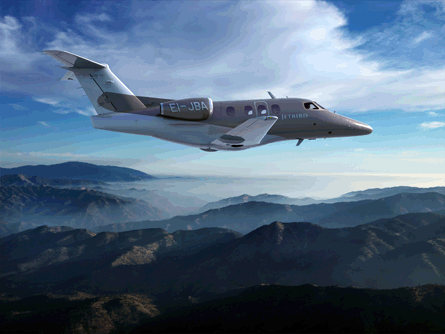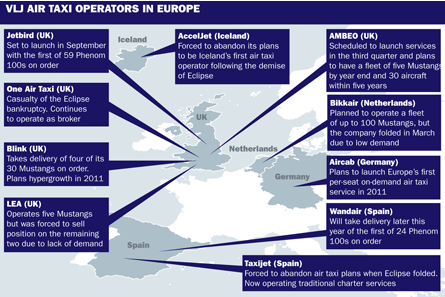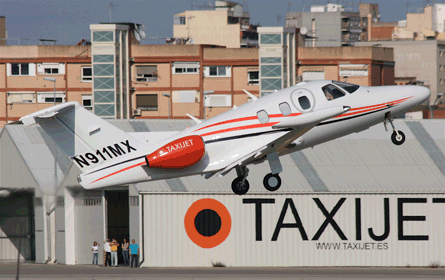What a difference a year makes. Europe's fledgling air taxi market was on the brink of an air transport revolution in early 2008 driven by a dozen or so start-ups, each with ambitions to revolutionise passenger travel with an array of high-utilisation, low-cost air taxi concepts using very light jets.
The USA was already proving fertile territory for its first wave of operators and Europe's newcomers were eager to emulate their success through a plethora of programmes designed to introduce the benefits of private aviation to a mass market, but at a fraction of the cost of traditional charter programmes.
However, the onset of the global recession and the demise of Eclipse Aviation - developer of the Eclipse 500 VLJ - in the last quarter of 2008 thwarted the ambitions of many.
 |
|---|
© Jetbird |
Start-ups with plans to inaugurate services in late 2008 and early 2009 were forced to abandon their strategies, leaving many operations saddled with debt. Other air taxi debutants were compelled to shut their doors within months due a lack of demand.
"This has been an economic fastdown rather than a slowdown," says Conor Neill, chief executive of Spanish air taxi start-up and management company Taxijet. "Nobody foresaw the speed with which a couple of bad mortgages in Florida could close down bad lending to all sectors."
Taxijet's business plan called for a fleet of 14 Eclipse 500s across five European bases by the end of June, building to 150 aircraft at bases in Europe and North Africa. Instead, the Madrid-based operator has only one of the six-seat VLJs and has been forced to scale down its operation drastically. "A lot of people have had their fingers burned by the collapse of Eclipse," Neill says. Eclipse entered Chapter 7 liquidation earlier this year.
SCORCHED FINGERS
Among those with scorched fingers were Taxijet's 14 Eclipse 500 owners, whose aircraft were to be operated under management by Taxijet, forming the backbone of the entire operation. These Spanish owners collectively have more than $3 million in deposits, which Taxijet is fighting to reclaim through US-based lawyers on their behalf. The company has also joined the consortium led by US air taxi operator LinearAir to bid for the maintenance and servicing-related assets of the bankrupt airframer. "There are 260 Eclipse 500s still flying and our main concern is making sure that all these aircraft are legally able to continue," says Neill. "A solution has to be found."
Neill's high expectations and dashed hopes are mirrored by other European start-ups that were also based on the Eclipse 500.
UK charter broker One Charter had planned to have five Eclipse 500s in its fleet by the end of the first quarter. "Our plan was to have 20 aircraft in our fleet within five years based across Europe providing low-cost air taxi operations," says One Charter chief executive Mike Ryan. "Instead, we have no aircraft, our [would-be management] customers and investors have lost thousands of pounds in non-refundable deposits and the years of work setting up the business has come to nothing."
 |
|---|
Click on graphic to view full size version |
One Charter will continue to operate as an aircraft broker. "We have battened down the hatches until we can come up with another plan," Ryan says.
Icelandic start-up AccelJet's dream of establishing the country's first low-cost air taxi operation last year was also dashed following Eclipse's downfall. The Reykjavik-based company says it has lost 10% deposits on two Eclipse 500s totalling over $300,000. "There is no chance that we will get our money back now," says chief executive Einar Arnarsson, who says he has no plans re-enter the air taxi market after such a disastrous experience. "Even if we were to reconsider, it has become very hard to get finance for new aircraft - particularly from the Iceland banks - and it will continue to be difficult to raise the money until there is a proven successful low-cost air taxi model in operation," says Arnarsson.
The first of the VLJ-based low-cost, no-frills air taxi operators was Bikkair. The Netherlands-based company was launched in March 2008 against a backdrop of high consumer spending and economic boom. Expectations were high for Bikkair, which planned to operate a fleet of up to 100 Cessna Citation Mustangs by 2012 from a network of bases situated no more than 30min flying time apart. After almost a year and with only two Mustangs in the fleet the company folded. Poor take-up and the scarcity of available funding was blamed for the collapse.
"It's a tough market to operate in," says Peter Leiman, founder and chief executive of fellow Mustang operator and low-cost air taxi company Blink, which started operations from its Farnborough, UK base a year ago. "When we launched Blink, we knew we had the right product at the right time, but it is slower than we initially thought." Leiman is continuing talks with several companies in the hope of signing the first corporate shuttle customers. "It is a tougher sell today," he says.
"But we are taking a prudent approach to our business. Air taxis are a capital intensive business - high costs and low revenues - and although we have raised $30 million, we need to be prudent with the money, which could fund Blink until 2011, when we expect to have hyper growth."
Blink has taken delivery of four Mustangs to date out of its 30-strong order tally. "We are still committed to the 30 aircraft, but [given the market conditions] we may stretch out the delivery schedule," says Leiman.
 |
|---|
© Blink |
This view is echoed by Patrick Margetson-Rushmore, chief executive of the UK's largest charter operator and fellow Mustang operator London Executive Aviation. The company has been forced to sell the position on the remaining two Mustangs scheduled for delivery this year due to a lack of demand for the smallest members of the London-based company's business jet fleet.
"We have five aircraft in the fleet and are getting 350h a year on each one," says Margetson-Rushmore, who has become increasingly sceptical of the air taxi concept. "The jury is still out on the air taxi market," he says.
"These models are based on high utilisation and low cost, but there is simply not enough business to create these operations now. Just to break even you need to be charging more than £1,100 [$1,610) per flying hour and flying more than 600h a year - these numbers can only be achieved in a very good year and even then you have the issue of seasonality."
MULTIPLE JOURNEYS
Margetson-Rushmore says the air taxi operators must do multiple journeys to hit the 1,200h a year utilisation mark for which many are striving, but a typical customer will hire the aircraft for around 2h and keep the aircraft all day. "We cannot underestimate the amount of time it will take to create this market," he says.
For Stefan Vilner, managing director of Ireland-based air taxi start-up JetBird, the answer is simple. "You have to ramp up your fleet as swiftly as possible," he says. "Low cost comes from economies of scale so you have to dive into the market and make a powerful, comparable product available to the traveller and stimulate the market by offering low fares."
JetBird plans to take delivery this month of the first of more than 59 Embraer Phenom 100s on order. The Dublin-based company - which also has an option on a further 41 Phenom 100s/300s - plans to begin services in September, three months later than planned due to the delay in the Phenom 100 European certification effort, which is now set for June.
"We will start services with four aircraft focusing on the Rhine-Ruhr region of Germany [one of Europe's largest metropolitan areas]. "We need to get up to scale quickly so we can begin to break even comfortably. Our goal is to operate 100 aircraft that will carry a combined total of 275,000 passengers a year." Vilner says there is a significant market in Germany, notably from leisure agencies offering travel packages and from cruise companies looking to transport passengers to their liners.
He cautions, however, that the market is more difficult to penetrate today. "These are lean and mean times and you have to argue the case for business aviation in a way you have never had to before. No-one has slammed the door in our face yet, but it is a very different marketplace today than it was when we first started looking at the air taxi concept."
JetBird and other air taxi operators have been targeting business class customers for whom the switch to small low-cost private jet travel could provide a welcome alternative. "Now we are out there talking to these customers and their position has changed. The dialogue has changed and many are either not travelling or sticking with airline travel."
Air taxi companies are focusing on private jet customers, either owners or users, who can no longer afford or justify travelling in larger business jets. Vilner says the "fat cat image" that has stifled the industry in recent months could be an advantage to the air taxi operators that challenge this perception by uniquely offering a no-frills, low-cost, point-to-point and efficient service.
JetBird has secured funding for the first 25 aircraft and is seeking to raise the necessary investment for the remaining 25. "We have enough investment to take us through to 2010, when we hope to see an improvement in the finance markets," says Vilner.
The global funding drought has placed a burden on the air taxi market. Frank Noppel, chief executive and co-founder of start-up Ambeo, says it has been difficult to secure finance from banks, but there have been opportunities from private equity firms. Ambeo has established its headquarters at Cambridge airport in the UK ahead of its planned launch this year. Ambeo says its business model calls for a mixture of owned and leased Mustangs - the least capital intensive method of running an air taxi operation, says Noppel.
The first aircraft in the Ambeo fleet will be leased through a private equity firm. "There are people who are willing to finance the aircraft - although we have had to fight harder to find them than a year ago - because there is a good business opportunity here," says Noppel. He suggests this is an auspicious time to buy new or used airframes that will hold their value over a long period. "A year ago you would pick a Mustang on the secondhand market for up to $3.2 million. Now a similar aircraft would be priced at around $2.3 million." Some delivery positions are equally well priced as manufacturers seek to sell cancelled or deferred orders.
SLOW BUILD-UP
In contrast to JetBird, Ambeo plans to scale its fleet slowly over the first 18 months. "We plan to operate like a traditional ad hoc charter company initially, operating under our own air operator's certificate up to five aircraft within the first 12 months. This will give us a solid base to expand the fleet with a view to operating up to 30 aircraft within five years."
 |
|---|
© Taxijet |
Noppel admits that the market has constricted since the Ambeo was conceived, but he remains convinced that enough demand exists - particularly from the corporate and private travellers - to launch another air taxi operator. "Of course it's tough out there and we don't expect to be getting more than 350h a year on our aircraft initially, but the recession won't last forever and we have to be ready for when the economy starts to pick up and people begin to travel again in greater numbers."
This market optimism and buoyancy is unlikely to be restored until 2011, says Paulo Sommariva, founder of what could be Europe's first per-seat on-demand air taxi service AirCab. He argues that Europe is not yet buoyant enough to support the air taxi model and he believes it is unlikely to show any signs of growth for at least two years.
"The travel market has been hardest hit at the lower end, from the midsize right down to the VLJs," he says. "Due to the recession, people do not have the same need or desire to travel, so the demand for air taxis is much lower today than it was a year ago."
Munich, Germany-based AirCab has yet to make a commitment to an aircraft type or manufacturer. The Mustang and Phenom have a solid reputation and pedigree, Sommariva argues, but based on a cost per seat, per kilometre basis the Eclipse 500 is still the most economical VLJ. "Last year we were looking closely at this aircraft, but didn't place an order or we would have lost a lot of money," he says.
Sommariva has not ruled Eclipse out of the equation. "We are still keeping a close eye on developments with the [bankrupt] company. We have the time to wait as we taking a comfortable approach to starting operations, concentrating for the time being on adding features to our flight planning, booking and ticketing software." These functions will go hand in hand with the service.
AirCab's plans calls for 25 aircraft "on day one" - covering 17 cities in central Europe - growing to 50 aircraft. "There are a number of good quality, well-priced aircraft on the secondary market and this will have a fundamental impact on our pricing model."
Despite his reservations, Sommariva is convinced that there is a "significant" market for air taxi operations in the medium term. "From the thousands of interviews we have conducted we realise the potential for a low-cost, point-to-point air taxi service and this market will become really interesting after 2011."
For Spain's Taxijet the option of providing a scalable air taxi operation before this timeframe are bleak following the collapse of Eclipse, which was to provide the aircraft to support the programme. "We are still set on providing an air taxi service for Europe, but [with only a single aircraft in the fleet] we have accepted that we can only provide a standard charter service for the time being," says O'Neill.
Taxijet is looking at other aircraft types, including the HondaJet and Spectrum's Independence and Freedom, although O'Neill believes the Eclipse 500, with its low direct operating costs, is an ideal air taxi. "We will have to see what happens to the company, perhaps it will find a new owner who may decide to restart production."
O'Neill harbours ambitions to operate a low-cost, pan-European air taxi company with up to 150 aircraft across Europe. "We still have that dream and plan to keep it alive."
Source: Flight International
















